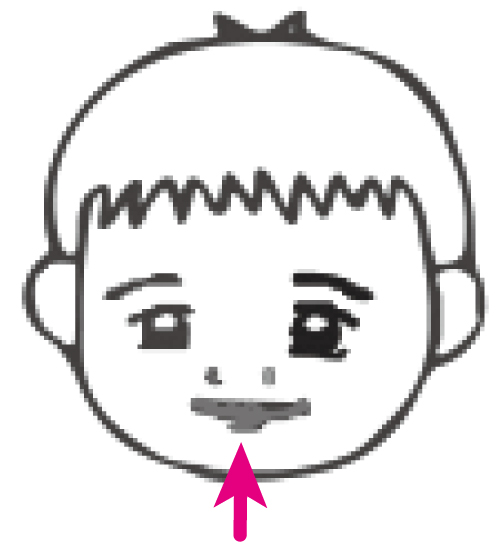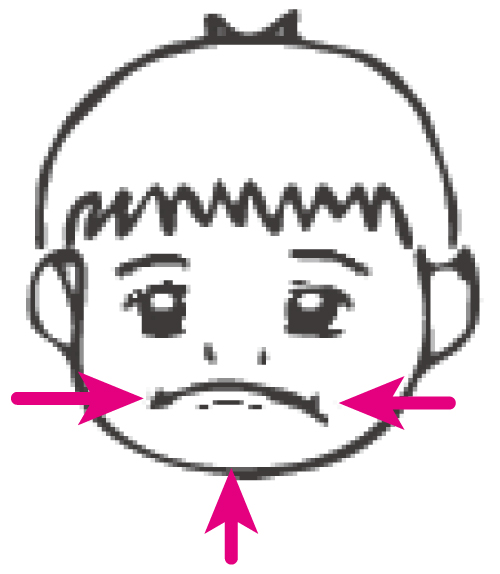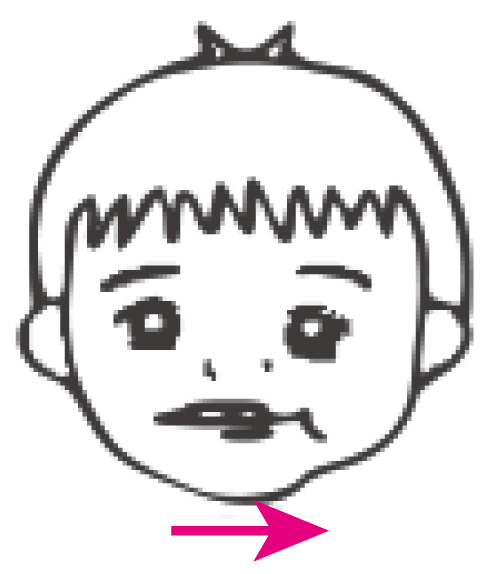Nutrition for Babies and Toddlers
− CONTENTS −
①Check bodily development and nutrition
④Why good nutrition matters in infancy and early childhood
⑨Dietary habits for early childhood
Infancy and early childhood are times of rapid growth that set the stage for lifelong health. Family members and caregivers should monitor a child’s growth and daily condition to be sure they’re getting enough energy and nutrients.
Never force feedings, whether breast milk, weaning foods, or regular meals. Take it slow, be patient, and enjoy watching your child grow.
①Check bodily development and nutrition
In early childhood, a child's body will change as it grows. Different children grow differently, and there can also be large differences in how each one obtains nutrition. Regularly measure your child's height and weight and record it on the bodily development curve graph. This will tell you about the child's bodily development and nutrition. If the growth line crosses percentiles, weight drops, or anything else concerns you, consult your regular medical provider or raise the issue at your child’s health check‑up.
②Breast-feeding
The mother's breasts provide basic nutrition for a baby. The first breast-feeding in particular will provide milk which contains a large amount of ingredients that protect the baby from illness. When the mother cannot breastfeed due to her own physical condition, illness, or work commitments, it is advisable to use formula.
Different babies drink different amounts of milk, so do not force your baby to drink if he or she does not want to. If your baby is happy drinking milk and his or her weight is increasing at a steady pace, you need not worry.
③How to prepare powdered milk
When preparing powdered milk, it is important to dissolve it with the right concentration, which is determined according to the product you're using. Well water and spring water can upset a baby's body due to bacteria. When giving your baby powdered milk or hydrating with water, use tap water, well water which passes a water quality inspection, or water in a container and made specifically for preparing milk.
Make sure to wash your hands before preparing baby formula with powdered milk. Dissolve the powdered milk into water that has been heated to at least 70 ̊C. Cool it down and make sure that it is around body temperature before you feed it to your baby. Make sure to throw away any leftover milk or any baby formula which is more than two hours old.
④ Importance of Nutrition and Diet in Infancy and Early Childhood
From birth, a baby’s main energy sources are breast milk and infant formula, but around five to six months of age they begin practising eating. Food texture gradually shifts from liquid to solid, the variety and amount of foods increase, and through these experiences infants develop feeding skills.
It is said that the tastes, preferences, and eating habits formed during this stage affect health later in life. Enjoyable mealtimes shared with family and others also spark a baby’s desire to eat. For sound mental and physical growth, create a pleasant dining atmosphere and establish regular eating habits.
⑤Weaning
As children grow, breast milk and formula alone cannot supply enough energy and nutrients, so these must be supplemented.
Weaning is when you begin to give soft, mashed food to a baby who has until that time only fed on breastmilk or formula. You will gradually increase the toughness of the food you feed and increase the variety of foods you serve. The meals you give your child during this period are called weaning foods. Around the age of five or six months is an appropriate time to begin feeding your baby soft, mashed food.
Note that there is no nutritional value from feeding your infant fruit juice before weaning. Start weaning when the baby is in a good mood and you have time. Take it slowly and follow the baby’s pace; it is fine for progress to advance and pause. Usually, at around five or seven months after birth, if you use a spoon or other such utensil to feed your baby, putting that utensil into the mouth will begin to weaken and eventually eliminate the desire to breast-feed, so you don't need to use a spoon for feeding until you begin weaning the child. Weaning should progress in gradual steps to make sure that your baby properly develops the ability to chew and swallow.
At around the age of nine to 10 months, your baby will begin to grab things to eat. Grabbing things to eat will develop a habit of eating independently and will feed a desire to do so.
By around 12 to 18 months of age, your child will be able to chew and crush solid foods.
⑥Targets for weaning
The timing at which a child no longer needs breast milk varies depending on the child's growth, development, the progress of weaning, and the home environment. Because determining when to stop breastfeeding can be difficult, it's important to make that decision based on the condition of the child and your own situation.
⑦Transitioning to weaning
Weaning is usually divided into four stages—early, middle, late, and completion—each with different food types, amounts, and degrees of texture and size. Wean your baby according to how he or she is growing and developing. In addition, try to acclimate your baby to a daily routine and make eating fun.
* Key points about weaning
i. Food types and combinations
As weaning progresses, increase the variety and quantity of food you feed your baby.
When you start weaning, begin with feeding rice porridge. When introducing a new food, feed your baby with a weaning spoon one spoonful at a time. Observe your child and increase quantity when he or she seems ready. When your baby becomes acclimated, introduce more types of food such as potatoes, carrots or other vegetables, as well as fruits. Later on you can also introduce tofu, white fish meat, hard-boiled eggs and so on.
As weaning progresses yet further, you can switch from white fish to red fish or blue-backed fish and from egg yolk to whole eggs. You can also add variety by introducing to your child easy-to-eat, fat-free meats, tofu, vegetables (such as green and yellow vegetables), seaweed, yogurt, as well as cheese containing little salt or fat.
Save fatty meats for a little later on. And avoid giving raw meat, fish, or eggs during the weaning period.
When your baby becomes used to not drinking milk for meals and you proceed to feeding two meals of solid food a day, serve meals with a combination of cereal (dietary staple), vegetables (side dish)/fruit, and protein-rich foods (main dish).
In addition, before preparing a family meal, separate the baby's ingredients beforehand and make sure your baby's meal includes foods with mild flavors. When you do that, your baby will enjoy a greater variety of meals and food preparation. If you use commercial baby food, taste a spoonful first to check the flavour and texture, and be sure it is not overheated.
There are reports that babies who are breast-fed develop a deficiency in iron or vitamin D at around six months of age. Therefore, it is important to begin weaning at the appropriate time and to intentionally introduce foods that are a source of iron and vitamin D. Of course, observe your baby's response as you introduce these foods.
There's no need to delay the introduction of solid foods other than the allergenic foods for children with food allergies. Proceed with introducing solid foods as usual while avoiding the specific foods identified by a doctor as allergens.
If weaning does not proceed smoothly, which leads to a high risk of iron deficiency, or you do not observe your baby gaining an appropriate amount of weight, first consult with a doctor, Then, as necessary, consider using follow-up formula.
If you give your baby regular milk (from a cow), it is said that you should not do so until after your child is one year old so as to prevent iron-deficiency anemia.
Honey poses a risk of causing infant botulism, so do not feed it to your child until after he or she becomes 1 year old.
ii. Cooking patterns and food preparation methods
As weaning progresses, prepare easy-to-eat food to serve your baby. Since your child's resistance to bacteria will be weak, make very sure to be thoroughly sanitary when preparing food.
Heat the food so it is hard enough to be mashed down in your child's mouth. Start with mashed rice porridge, and when your baby becomes used to that, give it a coarser texture and eventually proceed to unmashed rice porridge, followed by soft boiled rice. When you start serving vegetables and protein-rich foods, at first prepare it so that it is soft, and then gradually make it coarser. In the middle of weaning, your baby will be used to eating food all at once as he or she will have done with mashed food, so you need to find a way to make it thicker so that your baby swallows it properly.
For seasoning, when you begin weaning, your baby's food will not require seasoning. As weaning progresses, if you use flavoring agents such as table salt or sugar, bring out the unique flavor of each dish to prepare food with a mild taste. Use only small amounts of fat and oil.
⑧After weaning
When you finish weaning your baby, your baby will be able to bite down on and chew solid food and will now be getting the majority of energy and nutrition from food other than breastmilk or formula. This will happen at between 12 and 18 months of age, but this does not mean your baby will not drink breast milk or formula anymore. At around this time, feed your baby three meals and one or two snacks each day.
You should continue to give breast milk or formula milk based on the progress and completion of your child's weaning. The timing when a child no longer needs breast milk or formula varies depending on the child’s growth, development, the degree of weaning, and family environment. There is no fixed rule about when to stop, so it’s best to make a decision based on the child’s weaning status and the mother’s physical condition.
⑨Dietary habits for early childhood
Early childhood is a time to establish the foundation for dietary habits. It is important to get your child into the habit of eating regularly, and to make sure your child is eating food—including snacks—of the appropriate quantity and with nutritional balance, as well as to discourage picky eating, and to create an enjoyable family dining atmosphere.
Meal times set the rhythm for the whole day. Keep a steady schedule so late nights and missed breakfasts don’t become habitual.
During this stage, a child’s sense of taste is still developing, so their eating habits may be inconsistent. Rather than forcing them to eat, it’s best to gently observe and support them. So long as your child is in a good mood and following his or her typical daily routine, do not force your child to eat, but also do not take too much time feeding him or her.
If you have concerns or questions about breastfeeding, your baby’s growth, or nutrition, consult a registered dietitian at your municipality, or speak with a midwife, nurse, or nursery teacher at a hospital, public‑health centre, or health centre.
(Reference)
・About breastfeeding and weaning (Children and Families Agency)
・Allergy Portal(Japanese Society of Allergology)
・「Early to bed, early to rise, and Eat breakfast」(National Council)
| Weaning begins | → | Weaning complete | |||
|---|---|---|---|---|---|
| The targets provided below are merely guidelines. Adjust according to the appetite, growth and development of your child. | |||||
| Early Weaning Age 5-6 months |
Middle of Weaning Age 7-8 months |
Late Weaning Age 9-11 months |
After Weaning Age 12-18 months |
||
| Feeding Guidelines |
○Start feeding by spoon once a day while observing your child. ○Feed your baby as much breastmilk or formula as he or she wants. |
○Get your baby into a rhythm of having meals twice a day ○Add a greater variety of foods to enjoy experiencing different flavors and textures. |
○Stick to a dining routine and feed your baby three times a day. ○Dine together to build up enjoyable eating experiences. |
○Stick to a routine of eating meals three times a day and get your baby into a daily routine ○Have your baby grab things to eat to make eating independently more fun. |
|
| Preparations | Soft and mashed | Can mash with tongue | Can mash with gums | Can chew with gums | |
| Amount per meal | |||||
| Ⅰ | Cereal (g) |
Start with rice porridge. You can also try mashed vegetables. After your baby becomes used to this, try mashed tofu, white fish meat, egg yolk or the like. |
100% rice porridge 50-80 | 90% (rice porridge) – 80% (soft boiled rice) | 90% (soft boiled rice) – 80% (regular rice) |
| Ⅱ | Fruits & vegetables (g) | 20 〜 30 | 30 〜 40 | 40 〜 50 | |
| Ⅲ |
Fish (g) or meat (g) or tofu (g) or eggs (quantity) or dairy products (g) |
10 〜 15 10 〜 15 30 〜 40 1 egg yolk or 1⁄3 whole egg 50 〜 70 |
15 15 45 1⁄2 whole egg 80 |
15 〜 20 15 〜 20 50 〜 55 1⁄2 to 2⁄3 a whole egg 100 |
|
| Teething target | Baby teeth start to come in |
Your baby will have eight front teeth at around the age of one. The back teeth (the first baby molars) will start to come in during the latter half of the "After Weaning" stage. |
|||
| Eating function targets |
Your baby can open the mouth to take in or swallow food. 
|
Your baby can bite down with the upper and lower jaws. 
|
Your baby can mash objects with the gums. 
|
Your baby can use teeth. | |
* Serve your baby food which is easy to prepare and which you can thoroughly make sure is sanitary.
